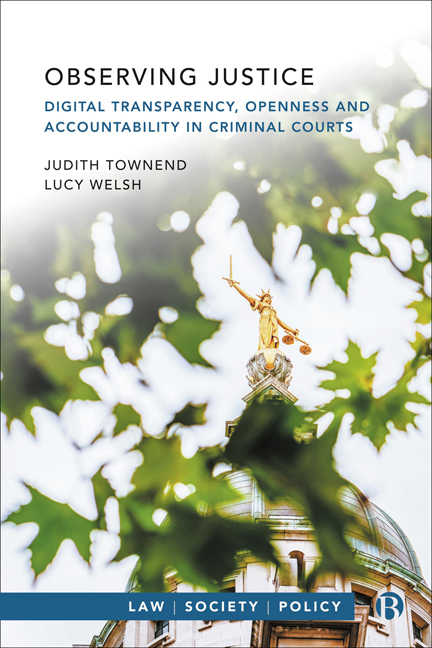Book contents
- Frontmatter
- Contents
- Series Editor’s Preface
- About the Authors
- Acknowledgements
- ONE Introduction: Why We Need to Rethink Approaches to Open Justice in the Criminal Courts
- TWO A History of Accountability in Criminal Courts
- THREE Justice System Modernisation, Digitalisation and Data
- FOUR The Role of the Public and Media in Observing Justice
- FIVE The Human Impact of Justice System Transparency
- SIX Conclusion: Towards a New Framework for Justice System Accountability
- References
- Index
FOUR - The Role of the Public and Media in Observing Justice
Published online by Cambridge University Press: 28 March 2024
- Frontmatter
- Contents
- Series Editor’s Preface
- About the Authors
- Acknowledgements
- ONE Introduction: Why We Need to Rethink Approaches to Open Justice in the Criminal Courts
- TWO A History of Accountability in Criminal Courts
- THREE Justice System Modernisation, Digitalisation and Data
- FOUR The Role of the Public and Media in Observing Justice
- FIVE The Human Impact of Justice System Transparency
- SIX Conclusion: Towards a New Framework for Justice System Accountability
- References
- Index
Summary
Introduction
Anyone who has directly participated in a court trial – whether as a witness, defendant or jury member – should have been exposed to how it operates in practice, with the possibility of members of the public and media in attendance. However, given dwindling numbers of public and media court observers, it is not clear how far public knowledge extends: whether many or most of the UK population knows of the core principle that justice must ‘be seen to be done’, and whether they understand what that means in practice. Recent research by Ipsos UK (the first of its kind) indicated ‘low awareness’ on public access to justice information: 70 per cent answering a nationally representative poll said they knew ‘not very much’ or ‘nothing at all’ about the information contained in court records (Gisborne et al 2022, p 17).
That is unsurprising in the lay context – low awareness or ignorance could be claimed about many features of English law – but the principle is also under-interrogated in more specialist contexts. For Sir Bob Neill MP, chair of the Justice Committee, despite its regular use, open justice is ‘perhaps not picked apart often enough’ (Gisborne et al 2022, p 6). There has been insufficient attention paid to the mechanics of open justice: the roles of different actors, the design of the channels and platforms, the financial costs (among other features). Because of the idiosyncratically decentralised and piecemeal nature of the justice system – where legal professionals and third-party services play a key role in the data ecosystem – many practices have evolved over time, in inefficient and unjust ways, without purposive design.
Important questions also remain in regards to data management: there has been astonishingly little – given the high stakes involved – public interrogation of the governance framework for justice system data, and the implication of privacy, data protection and intellectual property law on justice data sharing and public access. It would be useful to repeat the Ipsos research (Gisborne et al 2022) on members of the legal profession, the judiciary and court service to discover the level of awareness even within the system: anecdotal reports of misinterpreted rules, confusion over the access process would indicate that public access rights and rules are not well or widely understood despite the centrality of open justice as a principle of the common law.
- Type
- Chapter
- Information
- Observing JusticeDigital Transparency, Openness and Accountability in Criminal Courts, pp. 65 - 92Publisher: Bristol University PressPrint publication year: 2023

